The horse in spirituality
The horse is represented in spirituality mainly in white color, sometimes also in red, in gray and in black.
The white horse symbolizes the cosmos and the power of the cosmic all-love (Brihadaranyaka Upanishad, Varuna).The white horse is also the force of the Tapasya, which gallops on the summits of spiritual realization.
Revelation
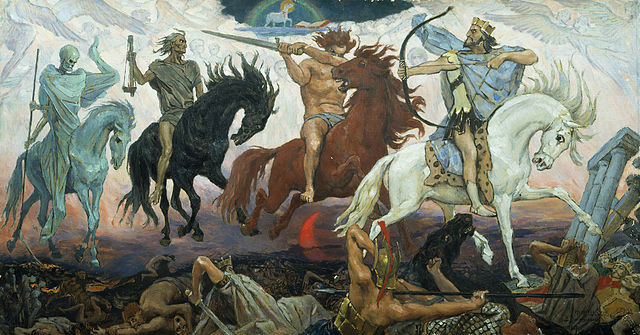
The John Apocalypse speaks in chapter 6 of four riders on horses.
- White horse, rider with bow: all-embracing love
- Red horse, rider with sword: symbol of wisdom
- Black horse, rider with scales: will (black horse also: low thinking)
- Gray pale horse, rider with spear: death
In chapters 19: 11-21, the rider on the white horse is victorious over the beast and the false prophet : I saw the sky open, and I saw a white horse, and he who sat upon it was called Faithful and Truthful, and judged and disputed with righteousness.
Emanuael Swedenborg wrote : 'Und daß sie bei Beschreibung des Ursprungs der Wissenschaften aus dem Verstand, ein geflügeltes Pferde darstellten, das mit dem Huf eine Quelle aufstieß, an der neun Jungfrauen waren, welche die Wissenschaften bezeichnen; denn aus den alten Kirchen war ihnen bekannt, daß durch das Pferd das Verständnis bezeichnet werde, durch Flügel geistig Wahres, durch den Huf Wissenschaftliches aus dem Verständnis, und durch die Quelle die Lehre, aus der die Wissenschaften stammen. Durch das Trojanische Pferd wurde nichts anderes bezeichnet, als ein ihrem Verstand entstammender Kunstgriff, die Mauern zu zerstören. Wenn heutzutage der Verstand in der von jenen Alten überkommenen Weise geschildert wird, pflegt er zwar durch ein fliegendes Pferd oder den Pegasus dargestellt zu werden, die Lehre durch eine Quelle, und die Wissenschaften durch Jungfrauen; aber kaum jemand weiß, daß das Pferd im mystischen Sinn das Verständnis bezeichnet, 'Über das weiße Pferd in der Offenbarung.'[4]
Bibel
Jehovah opened the eyes of the boy of Elisha, and he saw, and, behold, the mountain was full of horses, and a chariot of fire round about Elisha ', 2Kings.6/17
Buddhism
In Buddhism, Buddha with his servant Channa rides on his white horse Kantaka to the river Anoma, where he leaves it with his servant Channa.
Milarepa mentions the white horse as a force of his heart.
Ratnasambhava's throne is decorated with horses. Hayagriva is known in Tibet as rTa-mgrin (horse-necked).
The windhorse is an allegory for the human soul in the shamanist traditions of Asia.
In Tibetan Buddhism it is a symbol taken from the Bön and a central element in the center of the four allegorical animals of the heavenly directions.
The symbol has several slightly different names:
- хиймори, Chiimori or Hiimori : Mongolian for 'gas horse', winged, everyday meaning: soul.
- Rüzgar Tayi, Turkish for "Foals of the Wind".
- rlung-rta, tibetan for „ windhorse “.
Hinduism
In Hinduism, among many others >the seven-headed white horse Uchhaishravas is produced during the whirling of the milk ocean. It is also mentioned in Bhagavad Gita (10.27).
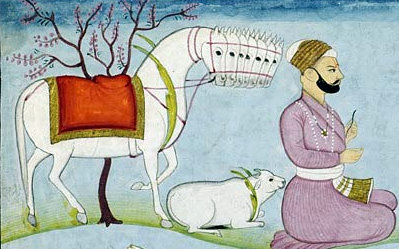
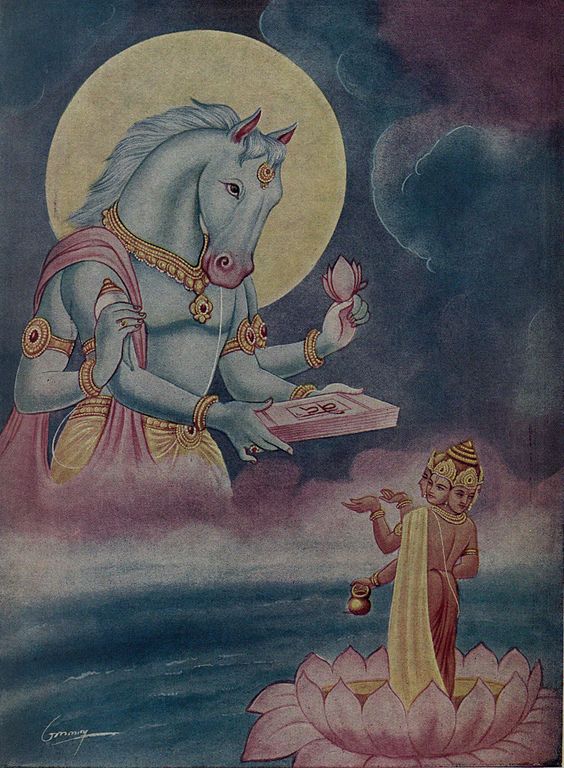
Hayagriva restoring the
Vedas to Brahma
In Hinduism, the horse-headed radiantly white Hayagriva is viewed as Avatar of Vishnu and revered as a deity of knowledge and wisdom. He iweares white clothes and sits on a white lotus (purity). He symbolizes the victory of the highest knowledge over the demonic forces of passion and darkness.
In chapter 4 of the Vishnu Purana, Sagara wanted a horse, which had been stolen by Vasudeva in disguise as Kapila.
The riding animal(vahana) of the Kalki is also a white horse.
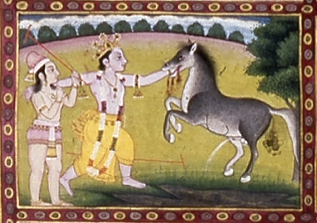
Mahabharata
In the Mahabharata - Appendix Savitri is Aswapati, the god of the horse and Savitri's human father, whom Sri Aurobindo sees as the god of Tapasya, the concerted energy of the spiritual effort that helps us to ascend to the immortal levels
In the Mahabharata Karna's chariot has milk-white horses and the Pandava Bhimasena has black horses.
In the Mahabharata the horse sacrifice was of great importance. It was carried out only by and to the exaltation of kings. 100 such Aśwamedha horse horses should make a mortal king stronger than Indra. A horse of a particular color was selected and then released for free wandering for 1 year. When the horse entered a foreign country, the ruler had to subdue or fight. When the liberator of the horse succeeded in subduing the lands, he returned in triumph with the defeated Rajas in his retinue. Otherwise, he was insulted and his claims mocked. After the successful return, a great festival took place, at which the horse was killed, either real or figuratively. Yudhishthira's big Aśwamedha horse-sacrifice set off a wild black horse from Hastinapur (City of the Elephants), which the Kurus had to follow everywhere>.
Brhadaranyka - Upanishad
The Brhadaranyka - Upanishad begins with a passage that strengthens the cosmic symbolism of the aswa.
Chapter 1 The world as a sacrificial horse begins with a correspondence between the physiology of the horse and the external world order, and the mysticism of the correlation can not be wrong:Aum, the dawn, truly, is the head of the sacrificial horse, the sun is the eye, the wind the breath, the open mouth the Vaishvanara fire. The year is the body of the sacrificial horse, the sky is the back, the atmosphere is the belly, the earth the hoof, the quarter the sides, the intermediate quarters the ribs, the seasons the limbs, the months and the half months the joints, days and nights the feet, the stars the bones, the clouds the flesh. The food in the stomach is the sand, the rivers are the blood vessels, the liver and the lungs are the mountains, the herbs and trees are the hairs.
The rising (sun) is the forefront, the sunset is the back part, when it yawns then it brightens, when it shakes it thunders, when it urinates then it rains. The voice is indeed his voice.
Chapter 2: Truly the day came after the horse when the (golden) vessel, called Mahiman (greatness), before the horse is placed. Its place is in the eastern sea. The night came after the horse was placed as a ship, called Mahiman, behind the horse>.
Its place is in the western sea. Certainly, these two vessels (or generations) emerged to be on each side of the horse. As a racehorse it carried the Devas, as a stallion the Gandharvas, as runners the Asuras, as a horse the humans. The sea is his family, the sea is his birthplace...
China
The horse ranks seventh in the Chinese zodiac. It practically represents love, perseverance, devotion and stability and is portrayed with fire and the dog and the tiger as a companion.
Islam
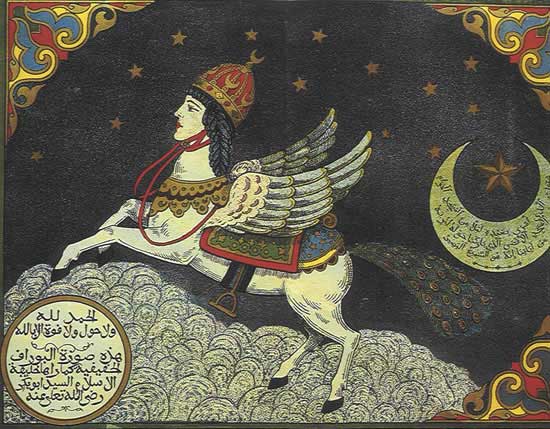
The Buraq (al-burāq) is in Islam a white horse-like riding animal with wings and crown and a human eye. According to tradition, the prophet Mohammed flew from the earth to heaven and back during a night. According to other traditions, he had also ridden on the Buraq with the Archangel Gabriel (Jibril) on an alleged journey from Mecca to Jerusalem.
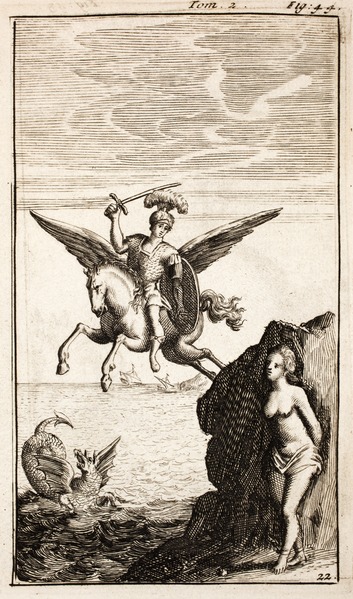
Greece
In Greek mythology there were several miracle horses: Kyllaros (Celeris) and Xanthos were given by Poseidon first the Hera.
Arion emerged from a union of Poseidon with Demeter. He was very fast and could speak. He belonged first to Onkios and then to Heracles. Later, Arion was given to Adrastos, king of Argos.
Heracles had to fight as the ninth act with the horse-riding Amazon-queen Hippolyte ('dark horse').
The winged horse Pegasos (Greek Πήγασος Pēgasos) originated from the blood of the killed Medusa.
White horses are the draft animals of the chariots of Eos and Helios. They are therefore considered to be sources of light.
Arkanscool
In books about symbology can be read that the horse stands for intellectual activity. The white horse symbolizes the enlightened thinking of the spiritual man and so we also find that in the Book of Revelations, Christ is riding on a white horse.
Black horses represent low-minded thinking with its false ideas and erroneous human concepts. The broodmares as we encounter them in this first task point to the feminine aspect of thinking as it creates ideas, theories, and concepts.
The inclination of thinking to create thought forms is symbolized here, how it dresses the received ideas into forms, which are released to the world, and when they flow out of the lower thinking, they are devastating and destructive, but building and redeeming when they come from the soul(Alice bailey : The labours of hercules, Pg. 34)
Literature
- A classical dictionary of Hindu mythology and religion, geography, history, and literature, Dowson, 1879 (online)
- The Handbook of Tibetan Buddhist Symbols, R. Beer, S. 67
References
- The Brihadaranyaka Upanishad - Chapter 1.1.1
- Horse in dreams
- Four_Horsemen_of_the_Apocalypse
- Swedenborgh about the white horse in the revelation of John
- Kanthaka
- Tibetgalerie : Symbole
- Temple of the white horse
- The Vishnu Purana, translated by Horace Hayman Wilson, [1840], Chapt. 4
- Sri Aurobindos Aswapati
- Mahabharata Online
- Ashvameda
- The Mahabharata , Book 14: Aswamedha Parva
- BRIHADÂRANYAKA-UPANISHAD, 1, 1
Weblinks
- White Horse
- Winged horse Pegasos
- The Wind horse as symbol of the soul
- Khandro about the Horse
of Spirituality
universal-path.org